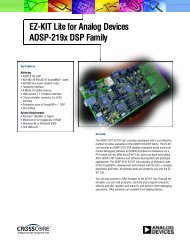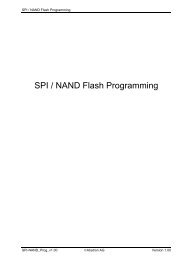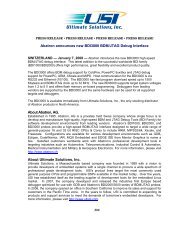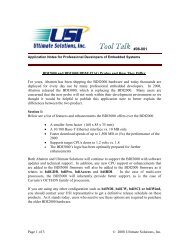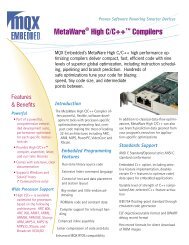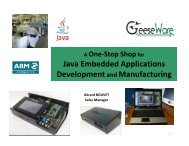STM32 Journal - Digikey
STM32 Journal - Digikey
STM32 Journal - Digikey
Create successful ePaper yourself
Turn your PDF publications into a flip-book with our unique Google optimized e-Paper software.
<strong>STM32</strong> <strong>Journal</strong><br />
size, managing power becomes<br />
more convoluted.<br />
With a real-time kernel, the<br />
CPU returns to the IDLE task<br />
whenever none of the tasks<br />
need attention. Because no<br />
tasks are currently running, it is<br />
much more straightforward to<br />
manage power. When the IDLE<br />
task is interrupted, the system<br />
can quickly be powered up. This<br />
gives developers the ability to<br />
take the system context into<br />
account when selecting a power<br />
mode and clock speed that<br />
provides the appropriate level<br />
of responsiveness (i.e., how<br />
fast the system can wake to an<br />
active state).<br />
Using the IDLE function to<br />
manage power also simplifies<br />
any migration of applications<br />
between <strong>STM32</strong> processors.<br />
For example, tuning an<br />
application based on the <strong>STM32</strong><br />
L1 for power may require a<br />
different approach compared<br />
to an <strong>STM32</strong> F0 or <strong>STM32</strong><br />
F4. By consolidating power<br />
management in a single routine,<br />
developers can be sure to be<br />
able to optimize efficiency<br />
without having to completely<br />
rewrite the application.<br />
Designing your own real-time<br />
kernel is an option. However,<br />
the use of a commercial<br />
real-time kernel like µC/OS-<br />
III from Micriµm provides a<br />
wide range of multitasking<br />
capabilities that make it easier<br />
to add new functionality to<br />
a system without impacting<br />
system reliability. For example,<br />
when a new feature like a<br />
GUI is introduced, it can be<br />
given a low priority. Thus, a<br />
critical system task such as<br />
driving the pump on a blood<br />
pressure monitor is always<br />
executed when it needs to be<br />
and not disrupted because<br />
a USB packet arrived at a<br />
critical moment. In this way,<br />
developers can extend the<br />
UI of a device, as well as its<br />
connectivity options, without<br />
negatively impacting reliability.<br />
A real-time kernel also<br />
simplifies design and power<br />
management as more complex<br />
functions are added to a<br />
system. For example, while<br />
executing a time-intensive<br />
function without a kernel,<br />
developers need to manually<br />
check within the function if<br />
shorter, higher priority tasks<br />
need attention. With µC/OS-<br />
III, multitasking and priority<br />
management is automatically<br />
managed, and developers can<br />
break their system into separate<br />
and distinct pieces without<br />
having to manually manage<br />
how these pieces interact. This<br />
also enables developers to<br />
more accurately measure power<br />
consumption during early<br />
design stages as well as verify<br />
where in their applications<br />
power spikes may be occurring.<br />
Certification is a concern for<br />
many manufacturers of medical<br />
devices as well. Given that it is<br />
the complete system that must<br />
be certified, the Micriµm µC/OS-<br />
III kernel and µC/TCP-IP stack<br />
are provided with source code<br />
and are fully documented so<br />
as to facilitate the certification<br />
process. Using the Micriµm<br />
kernel and stack can simplify<br />
certification compared to an<br />
in-house kernel implementation<br />
that does not have the maturity<br />
and years of industry testing<br />
commercial code offers.<br />
Rather than base a design on a<br />
specialized MCU that can serve<br />
only one price point, the <strong>STM32</strong><br />
F0 and <strong>STM32</strong> L1, along with<br />
the rest of the <strong>STM32</strong> families,<br />
provide a flexible architecture<br />
that can enable developers to<br />
leverage their code and other<br />
IP across an entire product<br />
line. In addition, code- and pincompatibility<br />
between devices<br />
allows for a nearly seamless<br />
migration between processors.<br />
Designing with the <strong>STM32</strong><br />
architecture is also faster<br />
compared to 8- or 16-bit MCUs.<br />
Specifically, 8- and 16-bit MCUs<br />
tend to have a limited tool chain,<br />
especially when the MCU vendor<br />
is the only source for tools.<br />
In contrast, the <strong>STM32</strong><br />
architecture is based on the ARM<br />
Cortex-M architecture. As such,<br />
it has the largest ecosystem<br />
available for any MCU. These<br />
tools provide more run-time<br />
information and advanced<br />
debugging capabilities to ensure<br />
system robustness and power<br />
efficiency, as well as verify device<br />
operation to speed certification.<br />
Creating portable medical<br />
devices requires an MCU<br />
architecture that provides<br />
both performance and power<br />
efficiency. With its tightly<br />
integrated architecture, <strong>STM32</strong><br />
MCUs offer a single-chip<br />
solution that balances cost<br />
and ultra-low-power operation.<br />
Combined with the powerful<br />
capabilities of production-ready<br />
software such as Micriµm’s µC/<br />
OS-III kernel and µC/TCP-IP<br />
stack, developers can bring<br />
reliable medical products to<br />
market faster.<br />
33




